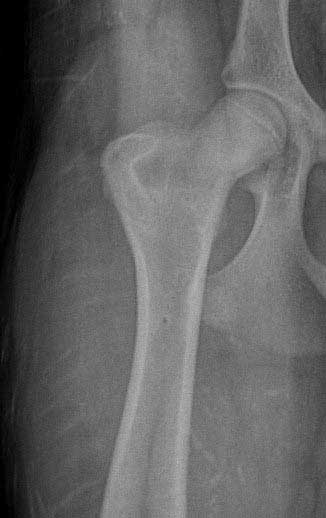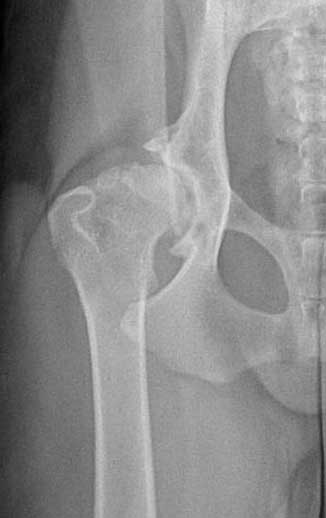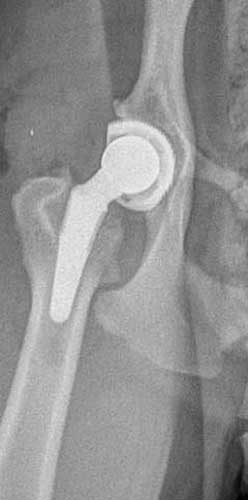Canine Hip Dysplasia
Hip Dysplasia is a common, inherited, developmental condition that involves increased laxity of the hip joint. It is one of the most common orthopedic abnormalities in young, giant, and large breeds, however all breeds can be afflicted. Although the exact cause of hip dysplasia has not been determined, many factors have been implicated. Genetics, rapid growth, excessive nutrition and diminished muscle mass have been associated with increased severity of hip dysplasia. Affected dogs are born with normal hips, but develop a lack of conformity between the femur and acetabular cup which invariably leads to the development of arthritis.
Call (406) 548‑4226 today to schedule an appointment with a veterinarian at Bridger Veterinary Specialists & Emergency.
Diagnosis
Dogs with hip dysplasia may present with signs of hip pain, commonly indicated by a reluctance to jump into the car, pain when rising, or inactivity and reluctance to play in puppies. Clinical signs are common between 6 and 12 months when there is excessive laxity and again in dogs over 3 years of age when arthritis becomes more severe. Diagnosis is based on physical examination findings of laxity or pain in the hips and confirmed with x-rays. We recommend screening examinations are performed by your regular veterinarian at four months of age in any large breed dog. Standard “hip extended” views combined with distraction views give the most information.

A Normal Hip

X-ray of hip with severe arthritis
Treatment
Many treatment options are available for hip dysplasia. Treatment is based on severity of signs, age at presentation, client expectations of performance, and financial considerations.
Medical Management—The most conservative method of treatment of hip dysplasia involves medical management consisting of weight loss, controlled activity and anti-inflammatory drugs or nutraceuticals (e.g. glucosamine, chondroitin sulfate). Many new non-steroidal anti-inflammatory drugs are available for dogs. Ask your family veterinarian which is best suited for your pet’s needs. Medical management does not reverse arthritis, but provides control of pain.
Double Pelvic Osteotomy (DPO)—Young dogs (6 to 18 months) that do not have significant arthritis are candidates for Double Pelvic Osteotomy (DPO). DPO improves femoral head coverage through a procedure that involves making three cuts in the bones of the pelvis, then rotating and plating a section of the pelvis. The goal of this surgery is to decrease pain and the progression of arthritis. Long term evaluation of dogs after DPO has shown excellent results.
Symphysiodesis—Symphysiodesis is a technique for preventative management of the progression of juvenile canine hip dysplasia. It involves closing the growth plate on the “floor” of the pelvis, increasing femoral head coverage. This technique can be performed relatively rapidly, is minimally invasive, and entails no surgical implants. Ideal candidates have hip laxity with no radiographic signs of arthritis andare between 15 and 20 weeks of age.
Femoral Head and Neck Ostectomy (FHO)—FHO is a salvage procedure to address hip dysplasia. This surgery involves removing the bone of the femoral head (Figure 5) and aims to eliminate the source of pain. Small dogs and cats may be better candidates for this procedure than large and giant breed dogs which may have prolonged recoveries and variable outcomes. Gait abnormalities may persist after FHO and post operative physical therapy is critical to the success of the procedure.

Femoral Head and Neck Ostectomy

Post-op Total Hip Replacement
Total Hip Replacement (THR)—THR involves implantation of a prosthetic hip in a similar fashion as is done in humans and has been well established in veterinary medicine since the 1970s. Both cemented and cementless options are available for dogs and your surgeon will discuss which would be best for your pet. The availability of many different implant sizes makes this the best option for most dogs with severe signs of hip problems. Ideal candidates are over eight months of age with no overt systemic illness. Although hip dysplasia is often a bilateral disease, THR is performed on only one hip at a time, with the most painful hip treated first. Often, only one hip needs to be replaced to achieve acceptable function. If pain persists, a second THR may be performed at least two months after the first.
As with any surgery, complications exist with THR and include infection, implant failure and femur fractures. These complications combined occur in less than 10% of patients and improvements in implant design and technique have led to the low complication rate. Full recovery from THR takes approximately eight weeks with many dogs able to walk on the affected leg the day after surgery. The success rate of THR is excellent with 90-95% of dogs able to have normal use of the affected limb after surgery.
To learn more about the diagnostic and treatment options available at Bridger Veterinary Specialists & Emergency contact us at (406) 548‑4226 or info@bvspets.com. If you are a referring veterinarian please review the information on our referral page.
